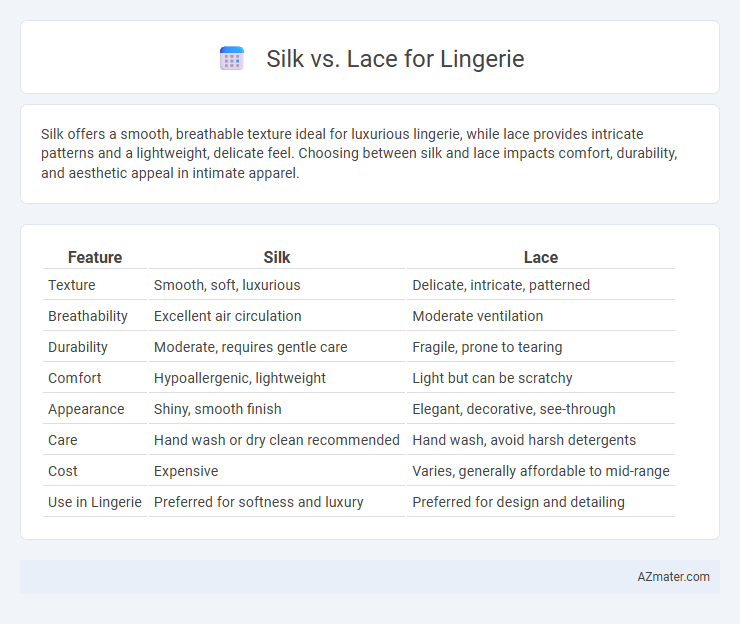Silk offers a smooth, breathable texture ideal for luxurious lingerie, while lace provides intricate patterns and a lightweight, delicate feel. Choosing between silk and lace impacts comfort, durability, and aesthetic appeal in intimate apparel.
Table of Comparison
| Feature | Silk | Lace |
|---|---|---|
| Texture | Smooth, soft, luxurious | Delicate, intricate, patterned |
| Breathability | Excellent air circulation | Moderate ventilation |
| Durability | Moderate, requires gentle care | Fragile, prone to tearing |
| Comfort | Hypoallergenic, lightweight | Light but can be scratchy |
| Appearance | Shiny, smooth finish | Elegant, decorative, see-through |
| Care | Hand wash or dry clean recommended | Hand wash, avoid harsh detergents |
| Cost | Expensive | Varies, generally affordable to mid-range |
| Use in Lingerie | Preferred for softness and luxury | Preferred for design and detailing |
Introduction: Silk vs Lace Lingerie
Silk lingerie offers a smooth, luxurious texture known for its natural breathability and hypoallergenic properties, making it ideal for sensitive skin. Lace lingerie provides intricate patterns and a sheer aesthetic that enhances visual appeal with delicate detailing and a lightweight feel. Both materials complement different preferences, balancing comfort, elegance, and sensuality in intimate apparel.
Historical Overview of Silk and Lace in Lingerie
Silk has been a luxurious fabric chosen for lingerie since ancient China, prized for its smooth texture and natural sheen, symbolizing wealth and sensuality throughout history. Lace, originating from 16th-century Europe, evolved as an intricate, decorative fabric that added delicate elegance and femininity to lingerie designs. Both materials reflect centuries of craftsmanship and artistry, with silk emphasizing comfort and allure, while lace offers ornamental sophistication and romantic appeal.
Texture and Feel: Silk Compared to Lace
Silk offers a smooth, luxurious texture that glides effortlessly against the skin, providing a soft and breathable feel ideal for all-day comfort. Lace, characterized by its intricate, open-weave patterns, delivers a delicate, slightly textured sensation that enhances visual appeal but may feel less silky and more structured. Choosing between silk and lace for lingerie prioritizes either the silky softness and temperature regulation of silk or the decorative, tactile intricacy of lace.
Aesthetic Appeal: Visual Differences
Silk lingerie exudes a smooth, lustrous sheen that catches the light, creating an elegant and luxurious appearance. Lace lingerie offers intricate, delicate patterns with a semi-transparent texture that adds a sensual and romantic allure. The visual contrast between silk's glossy surface and lace's detailed openness defines their distinct aesthetic appeals in intimate apparel.
Breathability and Comfort
Silk lingerie offers exceptional breathability due to its natural protein fibers, allowing moisture to evaporate and keeping the skin cool and dry. Lace, often made from synthetic or blended materials, provides moderate breathability but can sometimes retain heat, impacting comfort during extended wear. The smooth texture of silk enhances comfort by reducing skin irritation, while lace's intricate patterns deliver aesthetic appeal but may cause slight friction on sensitive skin.
Durability and Care Requirements
Silk lingerie offers luxurious softness but requires delicate care, including hand washing and air drying to maintain durability, as it is prone to damage from harsh detergents and high temperatures. Lace lingerie, often made from synthetic fibers like nylon or polyester, tends to be more durable and easier to care for, with many pieces being machine washable on gentle cycles. Choosing between silk and lace depends on balancing the desire for longevity with the willingness to perform meticulous maintenance.
Sensuality and Allure: Silk vs Lace
Silk lingerie exudes a luxurious sensuality with its smooth, glossy texture that delicately caresses the skin, enhancing natural curves and creating an intimate allure. Lace, known for its intricate patterns and semi-sheer qualities, offers a seductive appeal by combining elegance with a hint of mystery, making it a timeless choice for captivating designs. Both fabrics elevate lingerie sensuality but cater to different desires: silk for softness and intimacy, lace for visual intrigue and flirtation.
Price Comparison and Value
Silk lingerie generally commands higher prices due to the natural fiber's luxurious texture and durability, often ranging from $100 to $300 per piece. Lace lingerie, while still elegant and intricate, offers more affordable options typically priced between $30 and $100, making it accessible for budget-conscious shoppers. The value of silk lies in its softness and breathability, providing long-term comfort, whereas lace delivers aesthetic appeal and versatility at a lower cost.
Best Uses: When to Choose Silk or Lace
Silk lingerie is best chosen for its luxurious feel, breathability, and natural temperature-regulating properties, making it ideal for intimate occasions or everyday wear where comfort and elegance are prioritized. Lace lingerie excels in providing intricate detailing and a sensual, decorative appearance, perfect for special events or romantic nights when visual appeal and delicate texture are desired. Selecting silk offers smoothness and durability for prolonged use, while lace serves as an accentuating fabric that enhances aesthetic allure without compromising lightweight comfort.
Final Thoughts: Making Your Lingerie Choice
Silk lingerie offers unmatched softness and natural breathability, ideal for those valuing luxury and comfort. Lace lingerie provides intricate designs and a visually striking appeal, perfect for an elegant and sensual look. Choosing between silk and lace depends on whether you prioritize tactile comfort or aesthetic detail in your intimate wear.

Infographic: Silk vs Lace for Lingerie
 azmater.com
azmater.com